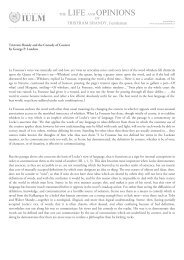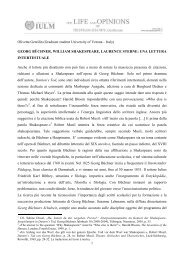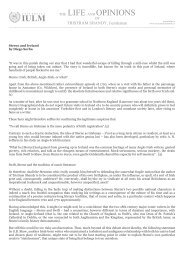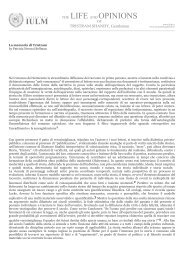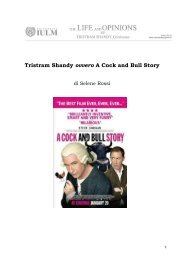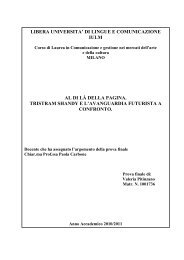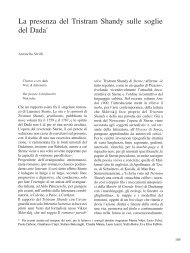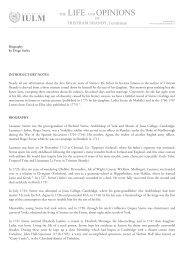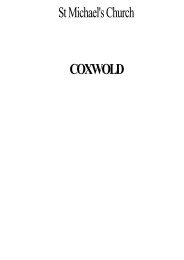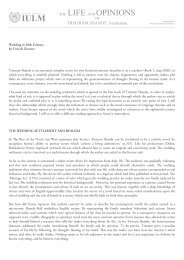Why Tristram Shandy By Bellman - The Tristram Shandy Web
Why Tristram Shandy By Bellman - The Tristram Shandy Web
Why Tristram Shandy By Bellman - The Tristram Shandy Web
Create successful ePaper yourself
Turn your PDF publications into a flip-book with our unique Google optimized e-Paper software.
<strong>Why</strong> <strong>Tristram</strong> <strong>Shandy</strong><br />
Patrizia Nerozzi <strong>Bellman</strong><br />
www.iulm.it<br />
www.tristramshandyweb.it<br />
From the blurred contours of early modernity �e Life and Opinions of <strong>Tristram</strong> <strong>Shandy</strong>, Gentleman (1759-1767) brightly<br />
beckons to the researcher in e-literature as an intriguing sign of "plagiarism in anticipation", 1 waiving more than one claim<br />
for the status of those printed texts which have in some way heralded the arrival of hypertext. In histories of literature <strong>Tristram</strong><br />
<strong>Shandy</strong> is often, as we might expect, referred to as a deliberate attack on the emerging canon of the Eighteenth century realistic<br />
novel, in so far as it is based on a coherent narration of probable events, an adequate dose of documentary details and accurate<br />
chronological references. Recurring observations are tuned to a leading motif: the narrative domain of Sterne's novel is ruled<br />
by unforeseen twists and turns of the plot which continuously subvert the predictable sequence of the autobiographical<br />
progression or, if we prefer, effectively annihilate the evolving pattern of the Bildungsroman. On the other hand in his struggle<br />
to capture life's accidents in their uniqueness and variety and fix them into meaningful autobiographical writing, <strong>Tristram</strong><br />
declares himself obsessed by tracing back the origins of events, seek ing to explore the objective cause of unpredictable effects.<br />
But in his uneven race against time (while he is writing his autobiography, his life goes inexorably on; the more he lives, the<br />
more he will have to write) he falls prey to the inextricable network of experience. �erefore the reader's legitimate<br />
expectations to discover the epistemological meaning inscribed in the title are paradoxically and parodically disoriented in a<br />
game with the author's imagination which he is doomed to lose. In <strong>Tristram</strong> <strong>Shandy</strong> unpredictability stipulates an inferred<br />
pact between narrator and reader proclaimed in a programmatic 'manifesto':<br />
"What these perplexities of my uncle Toby were, -'tis impossible for you to guess;-if you could-I should blush; not as a<br />
relation,-not as a man,-not even as a woman,-but I should blush as an author, in as much as I set not small store by myself<br />
upon this very account, that my reader has never yet been able to guess at any thing. And in this, Sir, I am of so nice and<br />
singular a humour, that if I thought you was able to form the least judgement or probable conjecture to yourself, of what was<br />
to come in the next page,-I would tear it out of my book" (Volume I. Chapter XXV).<br />
In fact, over the years, alongside the evolving poetics of the narrative genre, <strong>Tristram</strong> <strong>Shandy</strong>, "the most typical novel of the<br />
world", according to the well known verdict of Viktor Šhklovskij, has shown a permanent vocation to be re-interpreted<br />
according to the artistic ethos of the moment. From this point of view it may be significant to also mention the final, if<br />
derogatory, definition of Sterne as an "entrepreneur d'originalité", which the aristocratic Chateaubriand posited in his<br />
Memoirs d'outre-tombe. However from his evoked stance of superiority, the whiff of shop Chateubriand smells in the English<br />
author's restless commitment to subversion brings to light the middle-class, business-minded spirit of the new epic. At the<br />
other end, since the publication of Ulysses, another deviating milestone in the history of the novel, Joyce's influence on Sterne<br />
has long become a critical cliché, abounding in erroneous platitudes and forgetful of epoch-making scientific and philosophical<br />
discoveries.<br />
�ese desultory considerations on <strong>Tristram</strong> <strong>Shandy</strong>' s critical fortune lay no other claims but to sketch the background to our<br />
case study: <strong>Tristram</strong><strong>Shandy</strong><strong>Web</strong> (http://www.tristramshandyweb.it). With more intentions than solutions,<br />
<strong>Tristram</strong><strong>Shandy</strong><strong>Web</strong> was born over two years ago as a pragmatic consequence of my academic course on the Eighteenth<br />
century novel which happened to be contemporary with our équipe's new research projects and growing initiatives as to the<br />
relationship between humanistic sciences and digital technologies. At the Humanities Laboratory Research Centre of IULM<br />
University, originally the Language Centre, the expressive and cognitive potentials of Information Technology had constituted<br />
the backbone of our growing interest in the semiotic mechanism of textual transmission. Since <strong>Tristram</strong> <strong>Shandy</strong> can be<br />
considered an early demonstration of decentering, fragmentation, network distribution of the plot according to non-linear<br />
logic, we enthusiastically agreed that it was the 'ideal' text to be put under the magnifying lens of digital technology. Moreover
the interaction of written and visual textuality, which in Sterne's novel dramatically extends the imaginative experience of<br />
narrative, as also our search for the thoroughbass, created through the recurring allusion to music and sounds, spurred us on.<br />
Our guiding aim was to highlight the complexity of the novel through the tools of hypertext format, while avoiding a<br />
deconstruction of the text. As George Landow puts it:<br />
"We translate print into digital text and then hypertextualize it for several reasons: for accessibility, for convenience, and for<br />
intellectual or aesthetic enrichment, impractical or impossible with print …for practical reasons familiar to anyone teaching<br />
today: works around which I had planned portions of a course suddenly went out of print. Placing these otherwise unavailable<br />
documents within hypertext environment allowed us to create an economical, convenient electronic version of a reserve<br />
reading room, one that never closes and in which all materials always remain available to all readers who need them" 2<br />
It was our intention to create a place of learning and research, a handy tool for scholars and students. <strong>The</strong> text of our choice is<br />
not particularly rare nor out of print, but we have opted for a precise reference edition. 3 <strong>The</strong> source used is the SGML<br />
version deposited by Diana Patterson in the OTA (Oxford Text Archive). Oxford Computing Service gave us access to three<br />
text versions. <strong>The</strong> one we adopted is the first edition. We also chose to maintain the original carriage returns and the<br />
pressman's directions; this carried the added advantage of immediately re-evoking the original Eighteenth century edition<br />
whose layout we intentionally preserved unaltered. This left open the possibility of theoretical speculation both on the<br />
'original' text and on comparable different editions which accessed the reconstruction of the editorial history of the book.<br />
Flouting the rules of 'good' cybertext syntax, we paradoxically decided to keep <strong>Tristram</strong> <strong>Shandy</strong> at the centre of the screen,<br />
while the index of the novel and the menu of the nine sections (Arts, Fashion, History, HyperTS, Irishness, Language and<br />
Rhetoric, Music, Novel, Poetry) are disposed on either side of the text so as to signal its centrality and the framework of<br />
thesite.<br />
Being both an anatomy and an encyclopaedia of the Eighteenth century, <strong>Tristram</strong> <strong>Shandy</strong> presented itself as naturally prone to<br />
be investigated through different approaches and different disciplines, which we interlaced in a net supervised by experts. Each<br />
area is a sort of mini web, divided into three or four parts: Essays (contains articles on specific subjects), Net Resources and<br />
Bibliography (contains bibliography, with reference material available both on the web and on paper), Miscellaneous,<br />
Computational Linguistics (the results of a computational analysis carried out with TACT-Text Analysis Computing Tools).<br />
Moreover the individual section is opened using a pop up (i.e. a superimposed) window so that the text is always present on<br />
the screen.<br />
It might be said that through philological fidelity to the 'original' text, we have tried to avoid the risk of stretching our<br />
argument to the limits of absurdity, a common ailment of the entire cast of the novel. Undoubtedly what we did not want was<br />
to share their destiny and be taken up by a centripetal urge into the idiosyncratic pursuit of a self-characterising hobby.<br />
In a letter to Dr. John Eustace (February 9th 1768) Sterne writes: "[<strong>Tristram</strong> <strong>Shandy</strong> has] more handles than one…every one<br />
will take the handle which suits his convenience". Imagining his novel as a house with many different rooms among which the<br />
reader can choose where to enter, or, if we want to risk the definition, as a hyper-novel ante litteram, Sterne responds to the<br />
Eighteenth century interest in compendiums, treatises, dictionaries, encyclopaedias with a play on intertextuality which has no<br />
parallel in the history of the novel. Questions of philosophy, science, medicine, law, theology, astronomy, topography… find<br />
their place in digressions which explore the capacity of the novel as a versatile means of communication, able to contain within<br />
itself different kinds of discourse, incorporating scientific debates, legal acts, a marriage contract, theological controversies, a<br />
real sermon, an excommunication… Moreover the text is stuffed with references and quotations, more often than not,<br />
intentional miss - quotations, plays on words, sexual innuendo, learned allusions, lists, slangy language, excursions into an<br />
astonishing multiplicity of literary and non literary sources, extensive interpolations in Latin and French. 4<br />
In the Eighteenth century finding successful ways of reaching the emerging layers of a vertically expanding audience was a<br />
much debated question both directly and indirectly, inextricably connected, as it was, with the new concept of taste evolving<br />
in an increasingly business oriented literary market. <strong>The</strong> contamination of genres and styles, techniques and artistic devices,<br />
together with an attentive interaction between literature and the visual arts, bolstered the attempt to capture the reader's<br />
interest in "the infinite variety of human nature" (Henry Fielding). With no intention of dwelling on this demanding aesthetic<br />
quest, just a few general principles directly involved in our project will be mentioned. To slot living into writing Sterne<br />
expands the concept of writing to include other forms of visual artistry and communication, prefiguring a new type of
narrative space where the presence of the visual is not just figurative but more so cognitive. Not only typographical signs such<br />
as index fingers, asterisks, apostrophes, dots, the Shandian dash, but also graphics, the schematic pictures of the plot, a page of<br />
music, straight and sinuous lines, the black, marbled, dotted and blank pages… provoke an extension of writing, hence<br />
somehow preluding to and alluding to multimedial, interactive communication. Instead of describing a character, the narrator<br />
may call the reader to the stage and leave him a blank page on which to draw the woman of his dreams: "To conceive this<br />
right, - call for pen and ink - here's paper ready to your hand. - Sit down, Sir, paint her to your mind - as like your mistress as<br />
you can - as unlike your wife as your conscience will let you - 'tis all one to me - please but your fancy in it" (Volume VI.<br />
Chapter XXXVIII)<br />
Laurence Sterne's co-operation with William Hogarth was of primary importance in the development of the new realistic<br />
perspective and in the modes of relationship between the 'sister arts' - one of the main topics in the century's critical debate.<br />
Coming across what we thought were fascinating glimpses, our aim to explore and enhance the effects of the interaction<br />
between writing and visualising through different communication media was constantly stimulated by the crossing of parallel<br />
paths. Hogarth interlaces letters of the alphabet in his sketch for A Country Dance "to shew how few lines are necessary to<br />
express the first thoughts, as to different attitudes", 5 Sterne transforms the letters of the alphabet into a parade of knights:<br />
"… my Lord A, B, C, D, E, F, G, H, I, K, M, N, O, P, Q, and so on, all in a row, mounted upon their several horses; -<br />
some with large stirrups, getting on in a more grave and sober pace; - others on the contrary, tuck'd up to their chins, with<br />
whips across their mouths, scouring and scampering it away like so many little party-colour'd devils astride a mortgage, - and<br />
as if some of them were resolved to break their necks" (Volume I. Chapter VIII).<br />
In <strong>Tristram</strong> <strong>Shandy</strong> the protagonist's experience - and thoughts as well - form a net of inextricably related facts only in his<br />
intermittent and fragmented consciousness but resist any attempt to be ordered into a logical, chronological sequence. How<br />
can the writer and the reader, even if linked in a bond of complicity, mutually conceptualise and communicate the chaos of<br />
experience? Since the book is presented to the reader as a physical, concrete object made up of paper, printed letters and signs,<br />
implying a deliberate attack on contemporary publishing and printing techniques, the marbling of the page epitomises the<br />
maze of words where the reader is left free to find his own path in the labyrinthine digressions of the story.<br />
We are often reminded that the book is a theatrical performance: performing not only implies techniques of communication<br />
in which many arts are involved, but also that gradual and mutual adjustment of vision which is due to take place between the<br />
actors and the audience. According to Hogarth "the composed intricacy of form" can "lead the eye in a kind of chase" of the<br />
object in motion, "the same kind of sensation, which I have felt seeing a country-dance tho' perhaps the latter might be<br />
somewhat more engaging; particularly when my eye eagerly pursued a favourite dancer, through all the windings of the<br />
figure". 6 Dance implies abandon to rhythm:<br />
"Diddle, diddle, diddle, diddle, diddle, diddle - hum - dum - drum.<br />
-Your worships and your reverences love musick - and God has made you all with good ears - and some of you play<br />
delightfully yourselves - trut -prut, - prut - trut.<br />
O! there is - whom I could sit and hear whole days, - whose talents lie in making what he fiddles to be felt, - who inspires<br />
me with his joys and hopes, and puts the most hidden springs of my heart into motion" (Volume V. Chapter XV).<br />
Caught in between the hard sublimities of philosophical speculation and the sheer enjoyment of aesthetic pleasure the reader<br />
perceives that sense of dizziness which haunts him while he scrolls hypertext lexias. It is like finding your way led by that<br />
feeling of perplexed dismay which makes you hazard to say that Sterne somehow anticipated electronic writing, the structure<br />
and the interface of today's hypertext. A last note from Hogarth builds a daring bridge for our project According to Hogarth<br />
human flesh ( particularly the female complexion) which seen from a distance looks like an even texture is actually "composed<br />
of tender threads like network, fill'd with different colour'd juices". 7 <strong>The</strong> hyper realistic eye on the human body, seen as a<br />
system of springs, pipes and vessels, while taking us back to the mechanical philosophy of the early Enlightenment, downloads<br />
prompt directions for new technologies. In <strong>Tristram</strong> <strong>Shandy</strong> 'mechaniks' looks as if woven into the linguistic and figural<br />
texture of the novel and portrays human beings and social aggregations in terms of machinery.<br />
Born under the sign of the family clock and the ominous 'interruption' which had 'frightened' the sperm, <strong>Tristram</strong> is a living<br />
example, if ever there was one, of the fatal anachronism between the rigid, linear progression of time marked by the sequence
of events and the elusive, unpredictable measure of individual time. Reading the book, proceeding from digression to<br />
digression, can be at once absorbing and frustrating. It is slow reading and fast reading at the same time. Confident that the<br />
narrative reflects life, which is chaotic in its very nature, you get the impression of following hypertextual links, where you<br />
don't know what you will find, but are nervertheless involved in finding a connection, reading and re-writing, not interpreting<br />
but acting. Going back and forth, looking for a thread of a narrative, you feel compelled to drive on, caught in between the<br />
Eighteenth century autonomy of the narrator and the postmodernist autonomy of the fictive structure itself. Afraid of missing<br />
your way, advancing without map or instructions, sure that if you stop you are lost, and not only in a muddle of<br />
heterogeneous fragments, you are nevertheless called to understand "<strong>Tristram</strong>'s general system of belief", 8 in an endless chase<br />
where you know only that concluding is dying. <strong>The</strong> Sterne mystique has proved once again triumphantly successful:<br />
"Here are two senses (…) And here are two roads (…) - which shall we take?"
Notes<br />
1 M. Riva<br />
"Boccaccio online. Trasmissione dei classici e nuove tecnologie"<br />
in Internet e le Muse (Milano: Mimesis, 1997).<br />
2 G. P. Landow<br />
"Hypertext 2. 0. <strong>The</strong> Convergence of Contemporary Critical <strong>The</strong>ory and Technology"<br />
(Baltimore & London: <strong>The</strong> Johns Hopkins University Press, 1997)<br />
3 See P. Nerozzi <strong>Bellman</strong><br />
"<strong>Tristram</strong> <strong>Shandy</strong> <strong>Web</strong>", <strong>The</strong> Shandean, An Annual Volume Devoted to Laurence Sterne and his Works<br />
Published by the Laurence Sterne Trust, vol.13, 2002.<br />
4 See L.T. Milic<br />
"Information <strong>The</strong>ory and Style of <strong>Tristram</strong> <strong>Shandy</strong>"<br />
<strong>The</strong> Winged Skull, Papers from the Laurence Sterne Bicentary Conference (<strong>The</strong> Kent State University Press, 1971), 237-246.<br />
5 W. Hogarth<br />
<strong>The</strong> Analysis of Beauty (1753)<br />
New Haven: Yale University Press, 1997, 102.<br />
6 Ibid. 34.<br />
7 Ibid. 88.<br />
8 B. Rizzo<br />
"How could you, Madam, be so Inattentive? <strong>Tristram</strong>'s Relationship with the Reader"<br />
in M. New (ed.), Approaches to Teaching Sterne's <strong>Tristram</strong> <strong>Shandy</strong> (New York: Modern Language Association of America<br />
1989).



